

20171115 Just catalog it! Providing Access to 3 D Materials Recording.
Digital Libraries to School Libraries. Cataloging Basics: 8488 - School Library/Media Services. Cataloging Basics. WebDewey. 025.431: The Dewey blog. Dewey Decimal Classification System – ipl A+ Research & Writing. Children’s Subject Headings (CSH) List - Children’s and Young Adults’ Cataloging Program (CYAC): Cooperative Programs (Cataloging and Acquisitions, Library of Congress) The Children’s and Young Adult’s Cataloging Program provides cataloging tailored to the needs of children and young adults who use school and public libraries.

The CYAC Program catalogs items by creating bibliographic records complete with Children’s Subject Headings and a brief noncritical summary to offer easier subject access to those materials. CYAC catalogers apply current Library of Congress subject cataloging policies and practices, supplemented by CYAC policies. Note that MARC 21 coding is used to distinguish between Library of Congress Subject Headings (650 #0) and Children’s Subject Headings (650 #1). The catalog records are available from many sources because of their inclusion in the Library of Congress MARC database and the Cataloging-In-Publication Program. The cataloging records are available from several sources, as described in About the Program. One of the responsibilities of the CYAC Program is to maintain Children’s Subject Headings (CSH). CSH Proposals References.
Classifying CYAC Material - Children’s and Young Adults’ Cataloging Program (CYAC): Cooperative Programs (Cataloging and Acquisitions, Library of Congress) Generally, either the Library of Congress Classification or Dewey Decimal Classification (DDC) is used to arrange juvenile material.
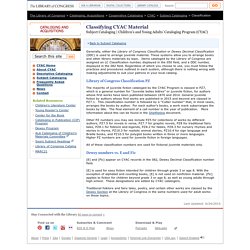
These systems allow you to arrange books and other library materials by topic. Items cataloged by the Library of Congress are assigned an LC Classification number, displayed in the 050 field, and a DDC number, displayed in the 082 field. Regardless of which you choose to use, you must follow the practices and procedures outlined in each system, although there is nothing wrong with making adjustments to suit your patrons in your local catalog. Sears List of Subject Headings. Explore the New Edition of Sears List of Subject Headings in Print and Online.

Access the Subject Headings you need for consistent cataloging in the Brand New Print Edition or in the New Online Database. The online database is free for one year with your print purchase, so you can try them both out! Take a Look at Some of the Key Features of the NEW Online Database Here. Click Here to Go to the Sears Online Database. Library of Congress Names - LC Linked Data Service: Authorities and Vocabularies. Understanding MARC Bibliographic: Parts 1 to 6. Library of Congress >> MARC >> Understanding MARC Part I: What Does MARC Mean?
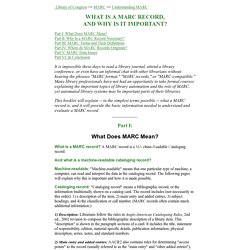
Part II: Why Is a MARC Record Necessary? Part III: MARC Terms and Their Definitions Part IV: Where do MARC Records Originate? Part V: MARC Data Issues Part VI: In Conclusion It is impossible these days to read a library journal, attend a library conference, or even have an informal chat with other librarians without hearing the phrases "MARC format," "MARC records," or "MARC-compatible. " This booklet will explain -- in the simplest terms possible -- what a MARC record is, and it will provide the basic information needed to understand and evaluate a MARC record. MARC STANDARDS (Network Development and MARC Standards Office, Library of Congress) Follett Software. Ms. MARC Article Index. Dewey Decimal Classification System – ipl A+ Research & Writing.
Access Points. General information on the data elements defined for use in the 1xx, 6xx, 7xx, and 8xx access point fields.
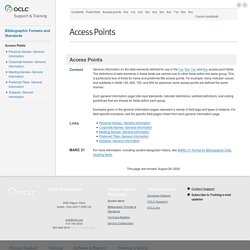
The definitions of data elements in these fields are carried over to other fields within the same group. This is particularly true of fields for name and preferred title access points. For example, many indicator values and subfields in fields 100, 600, 700, and 800 for personal name access points are defined the same manner. Each general information page lists input standards, indicator definitions, subfield definitions, and coding guidelines that are shared for fields within each group. Mitinet Library Services. ISBNdb. An Experimental Classification Service. Enter an ISBN, OCLC#, UPC, or ISSN Standard Number: An ISBN is a unique number assigned to an item by its publisher.
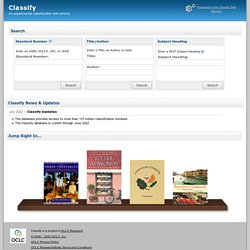
Each ISBN is a 10 or 13 digit number. Thirteen-digit ISBNs must begin with either 978 or 979. Enter ISBNs with our without hyphens. WorldCat.org: The World's Largest Library Catalog. Cataloger's Reference Directory: Tools and Resources for Cataloging and Metadata Librarians. 100+ Most Important Cataloging Tools and Resources for Cataloging and Metadata Librarians and Catalogers.
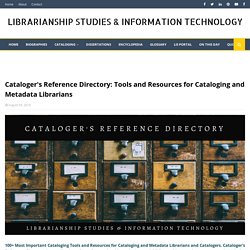
Cataloger's Reference Directory is a collection of top free and paid cataloging and bibliographic metadata resources. It includes sources for descriptive cataloging, subject cataloging, authority control, classification, subject headings, subject indexing, and metadata description. eCataloger [The eCataloger application provides cataloging utilities to create an eLibrary for an individual or small organization. The research goal of eCataloger is on creating semantic services for artifacts. It uses the FRBR (Functional Requirements for Bibliographic Records) framework to model the records using data elements and concepts from the MODS (Metadata Object Description Schema), MARC, and other current and developing cataloging and metadata standards.
Digital Libraries to School Libraries. Chapter 1 - Guidelines for Standardized Cataloging for Children. Joanna F.
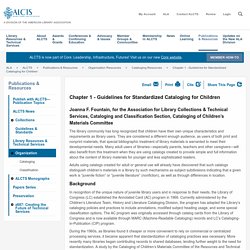
Fountain, for the Association for Library Collections & Technical Services, Cataloging and Classification Section, Cataloging of Children’s Materials Committee The library community has long recognized that children have their own unique characteristics and requirements as library users. They are considered a different enough audience, as users of both print and nonprint materials, that special bibliographic treatment of library materials is warranted to meet their developmental needs. Many adult users of libraries—especially parents, teachers and other caregivers—will also benefit from this treatment when they are using catalogs created to provide simple and full information about the content of library materials for younger and less sophisticated readers. Background.
Internet Library for Librarians. OLAC. Digital Libraries to School Libraries. Resource Description and Access (RDA) CAN A RECORD CATALOGED BY THE RDA STANDARD BE READILY IDENTIFIED?
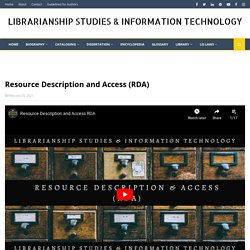
Yes, an RDA record will have both a value of “i” coded for Description and a 040 $e rda.WHAT DIFFERENCES WILL I SEE IN MY MARC RECORDS? You will see some notable differences in MARC records cataloged under the RDA standards. RDA records will not have General Material Designators (GMD’s—245 $h). Access Point. Access Point refers to a name, term, code, heading, word, phrase, etc., a unit of information representing a specific entity that can serve as a search key in information retrieval, under which a library catalog or bibliographic database may be searched and library materials may be identified and retrieved.
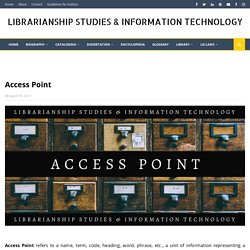
Access points are the indexed elements of an authority or bibliographic records that helps make the record searchable and identifiable. Authority Control. Authority Control is a process that organizes bibliographic information in library catalogs by using a single, distinct spelling of a name (heading) or a subject for each topic. Authority Record is a record which gives the authoritative form (the form selected for a heading) of a personal name, corporate name, family name, place name, uniform or preferred title, series title, subject, etc. in the library catalog or the file of bibliographic records, and are listed in an authority file containing headings of library items. [under revision] To ensure consistency, an authority record is created for each authorized heading (authorized access point) for a proper name or a subject, etc. An authority record is made when a heading is established, i.e., authorized for use as the main entry (preferred title and, if appropriate, the authorized access point for the creator), an added entry, or subject entry, for the first time, while cataloging of a library item.
Help us improve this article! RDA Core Elements. Core elements in Resource Description & Access (RDA) are minimum elements required for describing resources. Core elements are a new feature of RDA which allowed for certain metadata elements to be identified as “required” in the cataloging process. The assignment of core status is based on attributes mandatory for a national level record, as documented in the FRBR/FRAD modules. At a minimum, a bibliographic description should include all the required core elements that are applicable.
METIS - School Library Cataloging. What it is:Named after the mother of Athena, this library classification system for children PreK through 5 was created in 2011 by a team of librarians in New York who were questioning the use of the Dewey Decimal System in their library. They wanted to create a system that would better suit children and their ways of searching, creating a system that was more intuitive and followed their intellectual development more closely. Since the introduction of the system, the library has seen a significant increase in circulation, especially with children in grades three to five (Copeland, 2013).Please note that this system was created for a particular library in mind, but can be modified for use in other libraries. The breakdown of categories, subdivisions, and labels are available on their website for use under a Creative Commons license.How it Works:Metis uses whole language, visual cues, and logic that reflects the experiences of a child.
Image Credits: Weebly, Inc. Going Dewey-Lite…or even Dewey-Less – QSLiN. Going Dewey-Lite…or even Dewey-Less I’m ashamed to say that when dumping the Dewey Decimal System was suggested to me by an elementary school library volunteer, I huffed and puffed and continued to classify with those numbers. If I only knew then, what I know now! Going Dewey-Lite has many benefits in an elementary school library and if you’re still dead-set against it for high school, just watch this movie and see how elements of this philosophy can be used in high school libraries without going whole-hog-Dewey-Lite. This film shows how Joan Fraser-Burton and Sandra Dodge along with library volunteers at Harmony Elementary School in Chateauguay, Quebec switched to a word-oriented subject system. Joan is the Board documentation technician at New Frontiers School Board and she tells how she was inspired by an ABQLA presentation by Pam Harland to try this out in her own school.
The film also explains how the switch was made and how long it took. Like this: Like Loading... Six tools to simplify cataloging. Over the past year, I’ve discovered a number of handy, free tools for cataloging those materials we receive that do not come pre-cataloged. Here are a handful of tools that could save you lots of time. 1. Home - Cataloging Tools and Resources - LibGuides at American Library Association. WebClarity Software Inc. RDA for Copy Catalogers: The Basics. RDA for the Non-Cataloger - What's in it for You? The New CIP Data Block: How to Use It for Cataloging. Introduction LC Subject Headings, Part I.
Introduction to Sears Subject Headings I. Introduction to Sears Subject Headings II. WebDewey Number Building Tips and Tricks. Dewey Decimal Classification, Summer 2014, Session 1. Dewey Decimal Classification, Summer 2014, Session 2. ALCTS webinar presentation Version5. 025.431: The Dewey blog. Resources to help the cataloger catalog. Cataloging Metadata. Association for Library Collections & Technical Services (ALCTS) Contact Us | Diversity Statement | Statement of Conduct | Governance Governance | Mission & History | Sections ALCTS is the Association for Library Collections & Technical Services, a division of the American Library Association. CRS - Cataloger's Reference Shelf.